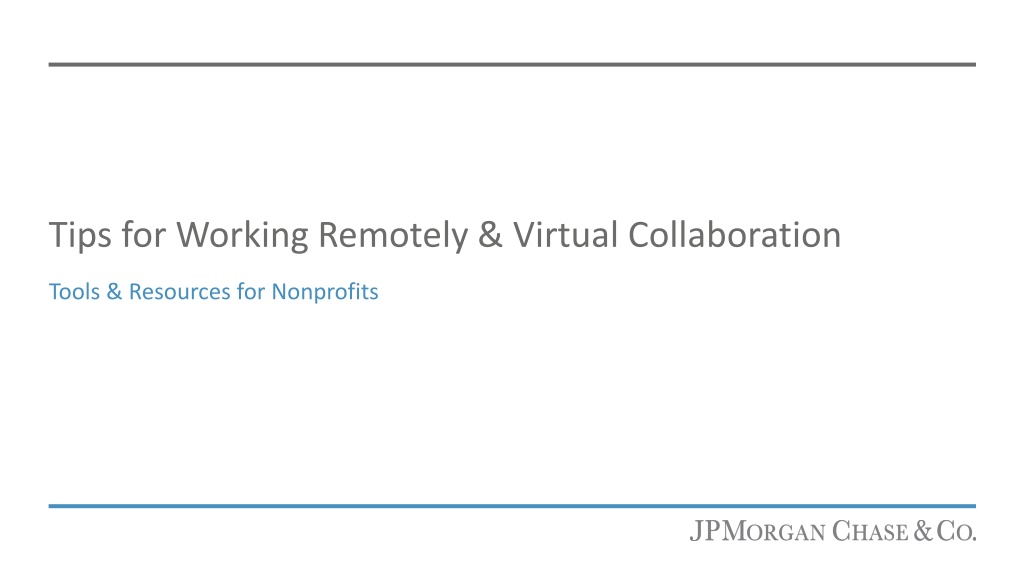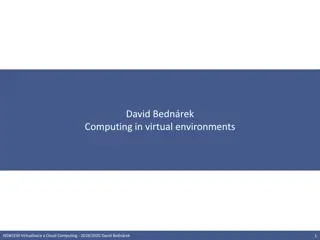Tips for Working Remotely & Virtual Collaboration Tools for Nonprofits
Share best practices for remote work and virtual collaboration in nonprofits. Explore strategies for effective team meetings and project collaboration. Learn about hosting virtual meetings and creating a productive work environment. Discover tools and resources to enhance virtual collaboration.
Download Presentation

Please find below an Image/Link to download the presentation.
The content on the website is provided AS IS for your information and personal use only. It may not be sold, licensed, or shared on other websites without obtaining consent from the author. Download presentation by click this link. If you encounter any issues during the download, it is possible that the publisher has removed the file from their server.
E N D
Presentation Transcript
Tips for Working Remotely & Virtual Collaboration Tools & Resources for Nonprofits
Legal Disclaimer The information included herein should never be used as a substitute for an organization s technical and/or operational judgment and does not represent an official position of JPMorgan Chase Bank, N.A. or its affiliates. This information is provided on an "as is" basis without warranty of any kind, express or implied.
Objectives Share tips and best practices for working virtually and ensuring your hope environment t is the foundation for your productivity. Discuss strategies to effectively collaborate across staff meetings, 1-on- 1 meetings, and project meetings based on a framework developed by Mary Alice Arthur (Story Activist). Review team and project collaboration tools currently on the market
Virtual Hosting in the New Abnormal Little actions count greatly because everything is amplified online. If you've been attending a poorly run meeting, it will be worse online. If you've been offering only one-way content or playing only to certain choices, it will be more obvious there's no participation. If there is disconnection in the group or the wider field, it will be more noticeable. But the reverse is also true. If you're with someone who knows how to create a container for connection and good collaboration, you'll come away feeling energized and stimulated. In forcing us online, this crisis has also created new and intriguing mixtures of people and the opportunity to make connection, collaboration and collective meaning in inspiring ways. Mary Alice Arthur, Story Activist 1
Framework for Collaboration & Hosting Focus Check-In Begin with the end in mind when hosting and preparing for a 1-on-1 or team meeting. Since the digital realm amplifies everything, if your meeting attendees are not paying attention or worse are openly multi-tasking it can really disrupt the focus of a meeting Avoid "slot management" wherein an agenda consists simply of slots being filled A Check-In helps team members become present by inviting their focus to this particular meeting Outcomes Checkout Clearly define what you want at the end of your project At the end of your meeting, make a clear close by including a Checkout Ask yourself what tangible and intangible results you want to produce in your 1-1-on-1 meetings and team meetings so that process pieces can fall easily into place Ask your teammate or team members what they are taking away or some insight they gained
Establishing Your Virtual Environment Curb isolation and sustain team culture by continuing to celebrate birthdays, recognitions, and other events virtually Try maintaining regular work hours to align yourself with the same work schedule at home Find a dedicated & comfortable sitting area while working from home Hold coffee or tea breaks that do not focus on work Check-In What is Going to Distract Me? Confirm that you have a strong Wi-Fi connection Focus On Culture Communicate with your team and manager what meeting pace works best for you and your at-home needs Minimize background noise ESTABLISHING YOUR VIRTUAL ENVIRONMENT Keep messaging short when using instant messaging Ensure your manager knows your accessibility needs Outcomes Productivity & Comfort Checkout Keep your objective in mind Video conferencing is a key component for virtual meetings & communications, so it s best to select the tool that allows proper camera and lighting Do I Have the Tools I Need? Establish the right tone & clear/concise verbiage upfront in emails, IMs, and videoconferencing Test sound from your computer to ensure it s in sync with the tool Avoid using absolutes such as never, always, impossible, or cannot. Soften the absolutes if you want to be more credible online
Driving a Virtual 1-on-1 Meeting Have a recurring calendar invite for one-on-one meetings Send an instant message if running late Body language is in listening mode Have an outlined agenda you would like to cover Recognize milestones and accomplishments Check-In What Do They Want to Talk About? Focus On the Individual Email tone is inviting Ask check-In questions: What inspired you today? What do you want to talk about today? Ensure you know the accessibility needs of the individual DRIVING A VIRTUAL 1-ON-1 MEETING Turn off all devices and notifications not needed for the meeting Revisit actions from the previous 1-on-1 Checkout What Do They Need Help With? Outcomes Feeling Heard & Having Clear Next Steps Use video when possible and offer an audio dial-in option as a back up Ask checkout questions: How can I help you? What do you need? How would they like to continue growing their professional development virtually? Send an email summary of action items Email tone is appreciative
Driving Virtual Team Meetings Match timing with the cadence of deliverables Introduce new team members Ensure everyone has access to the tools being used for the meeting Recognize team accomplishments Focus Check-In On the Product and Deliverables Ensure Everyone s Voice is Being Heard Email reminder for time sensitive action items and outcomes Remember to include participants on audio- only in conversation Ask check-In questions: What inspired you today? What do you want to talk about today? DRIVING VIRTUAL TEAM MEETINGS What have they completed? Ensure everyone has access to document repositories What are they working on? Ensure you know the accessibility needs of all team members Checkout Outcomes Team Feels Heard and Has Clear Next Steps What are their blockers? Ensure All Blockers Are identified Periodically ask for feedback on how meetings can be improved What is keeping them up at night?
Common Virtual Collaboration Tools TIP: Many software companies offer reduced or special rates for nonprofits. It never hurts to ask! Discussion Platforms & Social Networks Videoconferencing & Webinars Project Management Tools Document Sharing & Collaboration Project management tools offer teams a centralized hub for each project and an exact place where a team member can find resources for decision-making. Look for private platforms and tools that allow members to engage in meaningful relationships interact, collaborate, share, learn and solve their top-of-mind problems. Many videoconferencing tools have enhanced tools, such as live chat, polling, and screensharing that can make meetings more interactive and engaging. Cloud-based storage allows easy access to documents. Other tools also offer tools for simultaneous collaboration within a file. Examples: BulletinBoards, CreateAForum, Hoop.la, Nabble, Slack, Tapatalk Examples: Adobe Connect, Google Hangouts, GoToMeeting, Microsoft Teams, RIngCentral, Skype, WebEx, Zoom Examples: Asana, BaseCamp, Clutterpad, Evernote. Huddle, Jira, Trello Examples: Adobe Document Cloud, Box, DropBox, Google Docs, Google Drive, Microsoft SharePoint
Questions? Contact us at tech.for.social.good@jpmorgan.com























